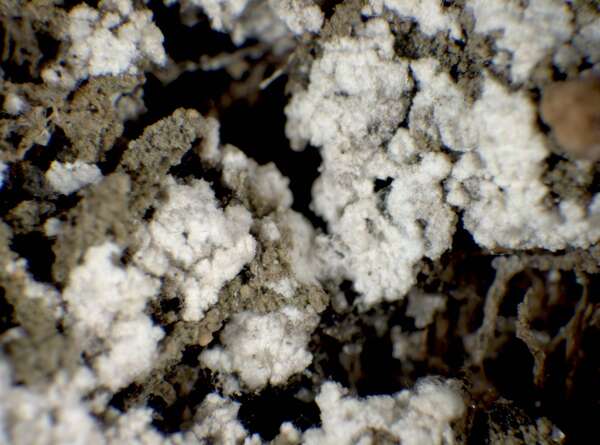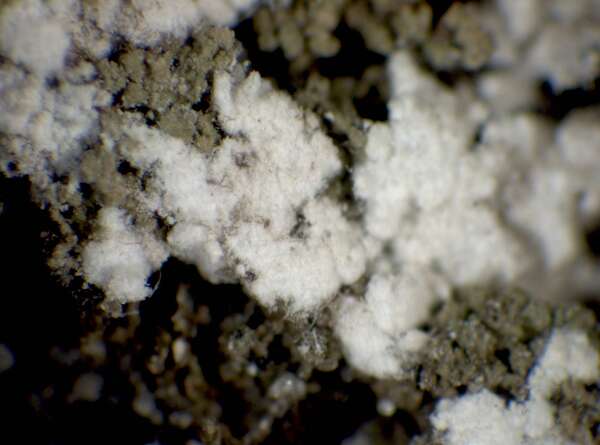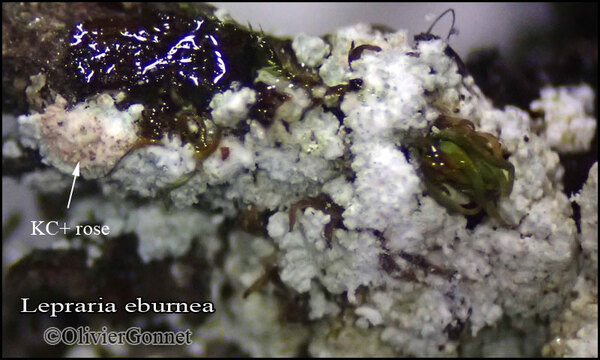Lepraria eburnea J.R. Laundon
Lichenologist, 24: 331, 1992.
Synonyms: Lepraria frigida J.R. Laundon
Distribution: N - Frl (Baruffo & al. 2006), VG (Baruffo & al. 2006), Ven (Baruffo & al. 2006), TAA (Leuckert & al. 2002, Baruffo & al. 2006, Bilovitz & al. 2014, Nascimbene & al. 2014, Nascimbene 2014, Nascimbene & Marini 2015, Trindade & al. 2021), Lomb (Ravera & al. 2018), VA (TO 3232), Emil (Baruffo & al. 2006, Fariselli & al. 2020), Lig (Baruffo & al. 2006, Giordani & al. 2016, 2025). C - Tosc (Baruffo & al. 2006, Benesperi & al. 2007), Marc (Baruffo & al. 2006), Umb (Baruffo & al. 2006, Ravera & al. 2006, Panfili 2007), Laz (Baruffo & al. 2006), Abr (Nimis & Tretiach 1999, Baruffo & al. 2006, Corona & al. 2016, Di Nuzzo & al. 2021, Gheza & al. 2021, Vallese & al. 2022), Mol (Nimis & Tretiach 1999, Baruffo & al. 2006, Caporale & al. 2008). S - Cal (Baruffo & al. 2006).
Description: Thallus leprose, cottony, whitish to greenish grey, often with a yellowish tinge, 0.2-0.5 mm thick, sharply delimited, orbicular at least when young, usually without marginal lobes, but sometimes weakly sublobate, consisting of a mass of powdery, spherical, (22-)33-70(-150) µm thick granules with up to c. 40 µm long, protruding, but never clam-shaped hyphae. Medulla white, not always evident, UV+ violet, the hyphae 2-4.5 µm thick, covered in small colourless crystals. The thallus stains herbarium paper red-brown after some years due to the presence of alectorialic acid. Photobiont chlorococcoid, the cells up to 20 µm diam. Spot tests: K- or K+ yellowish, C+ faintly yellow or pink, KC+ pink to reddish orange (reaction sometimes ephemeral), P+ yellow slowly turning orange or P+ rapidly orange, UV-. Chemistry: three chemotypes: 1) alectorialic acid only, 2) alectorialic and protocetraric acids, 3) alectorialic and psoromic acids.Note: on a wide variety of substrata, mostly on old trunks with subneutral bark, but also on rocks (including walls in urban areas), soil and mosses, avoiding very acid substrata and mostly on more or less rain-sheltered surfaces; certainly more common throughout the country, below the subalpine belt.
Growth form: Leprose
Photobiont: green algae other than Trentepohlia
Reproductive strategy: mainly asexual, by soredia, or soredia-like structures (e.g. blastidia)
In underhangs rarely wetted by rain
Commonnes-rarity: (info)
Alpine belt: absent
Subalpine belt: absent
Oromediterranean belt: absent
Montane belt: rather common
Submediterranean belt: common
Padanian area: rather common
Humid submediterranean belt: very rare
Humid mediterranean belt: absent
Dry mediterranean belt: extremely rare

Predictive model
Herbarium samples


P.L. Nimis; Owner: Department of Life Sciences, University of Trieste
Herbarium: TSB (32753)
2001/12/13


P.L. Nimis; Owner: Department of Life Sciences, University of Trieste
Herbarium: TSB (32753)
2001/12/13
Growth form: Leprose
Photobiont: green algae other than Trentepohlia
Reproductive strategy: mainly asexual, by soredia, or soredia-like structures (e.g. blastidia)
In underhangs rarely wetted by rain
Commonnes-rarity: (info)
Alpine belt: absent
Subalpine belt: absent
Oromediterranean belt: absent
Montane belt: rather common
Submediterranean belt: common
Padanian area: rather common
Humid submediterranean belt: very rare
Humid mediterranean belt: absent
Dry mediterranean belt: extremely rare

Predictive model
| Herbarium samples |


P.L. Nimis; Owner: Department of Life Sciences, University of Trieste
Herbarium: TSB (32753)
2001/12/13


 INDEX FUNGORUM
INDEX FUNGORUM
 GBIF
GBIF
 DOLICHENS
DOLICHENS



